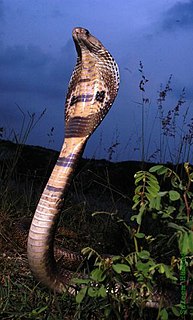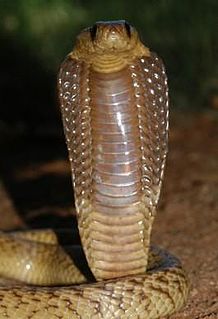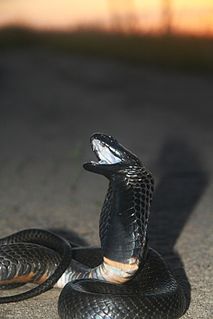
Mambas are fast moving highly venomous snakes of the genus Dendroaspis in the family Elapidae. Four extant species are recognised currently; three of those four species are essentially arboreal and green in colour, whereas the black mamba, Dendroaspis polylepis, is largely terrestrial and generally brown or grey in colour. All are native to various regions in sub-Saharan Africa and all are feared throughout their ranges, especially the black mamba. In Africa there are many legends and stories about mambas.

Tiger snakes are a large and highly venomous snake of southern Australia, including its coastal islands and Tasmania. These snakes are often observered and locally well known by their banding, black and yellow like a tiger, although the species can be highly variable in coloration and patterning. All populations are classified within the genus Notechis (Elapidae), their diverse characteristics have been classified either as distinct species or by subspecies and regional variation.

The Indian cobra, also known as the spectacled cobra, Asian cobra, or binocellate cobra, is a species of the genus Naja found, in India, Pakistan, Bangladesh, Sri Lanka, Nepal, and Bhutan, and a member of the "big four" species that inflict the most snakebites on humans in India. It is distinct from the king cobra which belongs to the monotypic genus Ophiophagus. The Indian cobra is revered in Indian mythology and culture, and is often seen with snake charmers. It is now protected in India under the Indian Wildlife Protection Act (1972).

The Cape cobra, also called the yellow cobra, is a moderate-sized, highly venomous species of cobra inhabiting a wide variety of biomes across southern Africa including arid savanna, fynbos, bushveld, desert and semi-desert regions. The species is diurnal and is a feeding generalist, preying on a number of different species and carrion. Predators of this species include birds of prey, honey badgers and various species of mongoose. The Cape cobra is also known as the "geelslang" and "bruinkapel" in South Africa. Afrikaans speaking South Africans also refer to the Cape cobra as "koperkapel", mainly because of a rich yellow colour variation. This species has no known subspecies.

The Philippine cobra also called philippine spitting cobra or northern Philippine cobra, is a stocky, highly venomous species of spitting cobra native to the northern regions of the Philippines. The Philippine cobra is called ulupong in Tagalog, carasaen in Ilocano, and agwáson or banákon in Cebuano.

Naja is a genus of venomous elapid snakes known as cobras. Members of the genus Naja are the most widespread and the most widely recognized as "true" cobras. Various species occur in regions throughout Africa, Southwest Asia, South Asia, and Southeast Asia. Several other elapid species are also called "cobras", such as the king cobra and the rinkhals, but neither are true cobras, in that they do not belong to the genus Naja, but instead each belong to monotypic genera Hemachatus and Ophiophagus.

The Mozambique spitting cobra is a highly venomous species of spitting cobra native to Africa. It is largely found in Angola, Botswana, Malawi, Mozambique, Namibia, South Africa, Tanzania, Zambia and Zimbabwe.

The Chinese cobra, also called the Taiwan cobra, is a species of cobra in the family Elapidae, found mostly in southern China and a couple of neighboring nations and islands. It is one of the most prevalent venomous snakes in China and Taiwan, which has caused many snakebite incidents to humans.

The rinkhals is a species of venomous elapid found in parts of southern Africa. It is not a true cobra in that it does not belong to the genus Naja, but instead belongs to the monotypic genus Hemachatus. While rinkhals bear a great resemblance to true cobras they also possess some remarkable differences from these, resulting in their placement outside the genus Naja.

The red spitting cobra is a species of spitting cobra native to Africa.

The Egyptian cobra, also known as "أورايوس" in Egyptian Arabic pronounced: Ouraeus(derived from the Ancient Greek word: οὐραῖος - Greek pronunciation: [οὐραῖος]), is one of the most venomous snakes in North Africa, which has caused many snakebite incidents to humans. It averages roughly 1.4 metres (4.6 ft), with the longest recorded specimen measuring 2.59 metres (8.5 ft).
Naja ashei, commonly known as Ashe's spitting cobra or the giant spitting cobra, is a species of venomous snake in the family Elapidae. The species is native to Africa. It is the world's largest species of spitting cobra.

The black-necked spitting cobra is a species of spitting cobra found mostly in sub-Saharan Africa. They are moderately sized snakes that can grow to a length of 1.2 to 2.2 m in length. Their coloration and markings can vary considerably. They prey primarily on small rodents. They possess medically significant venom, although the mortality rate for untreated bites on humans is relatively low. Like other spitting cobras, they can eject venom from their fangs when threatened. The neurotoxic venom irritates the skin, causing blisters and inflammation, and can cause permanent blindness if the venom makes contact with the eyes and is not washed off.

The forest cobra, also commonly called the black cobra and the black and white-lipped cobra, is a species of venomous snake in the family Elapidae. The species is native to Africa, mostly the central and western parts of the continent. It is the largest true cobra species with a record length of 3.2 metres. Although it prefers lowland forest and moist savanna habitats, this cobra is highly adaptable and can be found in drier climates within its geographical range. It is a very capable swimmer and is often considered to be semi-aquatic. The forest cobra is a generalist in its feeding habits, having a highly varied diet: anything from large insects to small mammals and other reptiles. This species is alert, nervous and is considered to be a very dangerous snake. When cornered or molested, it will assume the typical cobra warning posture by raising its fore body off the ground, spreading a narrow hood, and hissing loudly. Bites to humans are less common than from other African cobras due to various factors, though a bite from this species is a life-threatening emergency.

The Sumatra the Equatorial spitting cobra also called the black spitting cobra, Malayan spitting cobra, golden spitting cobra, Sumatran spitting cobra, or Palawan spitting cobra, is a species of spitting cobra found in Southeast Asia.

The Arabian cobra is a species of venomous snake in the family Elapidae. The species is endemic to the Arabian Peninsula. The cobra within the peninsula is a concern, with having a major cause of mortality rate in the region.

Naja nigricincta is a species of spitting cobra in the genus Naja, belonging to the family Elapidae. The species is native to the deserts and drier regions of southern Africa. The species is largely nocturnal, and is often found while crossing roads at night. There are two recognized subspecies.

Naja christyi, commonly known as the Congo water cobra or Christy's water cobra, is a species of venomous snakes belonging to the family Elapidae. The species is native to Sub-Saharan Africa. This species was formerly in the genus Boulengerina, but more recent research by Wallach et al. has shown that Boulengerina is actually a subgenus and Boulengerina christyi is a synonym of Naja christyi. This species has no known subspecies.

Anchieta's cobra, sometimes referred to as the Angolan cobra, is a species of venomous snake in the family Elapidae. The species is native to Southern Africa.





















